Are you dreaming of a porch makeover but worried about the cost? You’re not alone.
Many homeowners long for a beautiful porch ceiling but are deterred by the potential expense. But what if we told you that you could transform your porch ceiling without breaking the bank?
In this comprehensive guide, we’ll explore a variety of budget-friendly porch ceiling materials, provide DIY installation tips, and share real-life examples of porch ceiling transformations.
When I decided to refresh my own porch, I discovered that adding a chic beadboard ceiling was not only cost-effective but also completely transformed the look and feel of the area. It’s a project that brings a classic charm to any porch, enhancing its overall aesthetic appeal. For those inspired to undertake a similar upgrade, Amazon offers a variety of beadboard options that cater to different styles and budgets.
Table of Contents
- Understanding Porch Ceilings
- Exploring Inexpensive Porch Ceiling Materials
- DIY Installation Tips for Inexpensive Porch Ceilings
- Maintaining Your Inexpensive Porch Ceiling
- Maximizing Style on a Budget
- Cost Comparisons Between Different Porch Ceiling Materials
- Real-Life Examples of Inexpensive Porch Ceiling Transformations
- Enhancing Porch Ceilings Creatively and Affordably
- Frequently Asked Questions about Inexpensive Porch Ceilings
- Conclusion
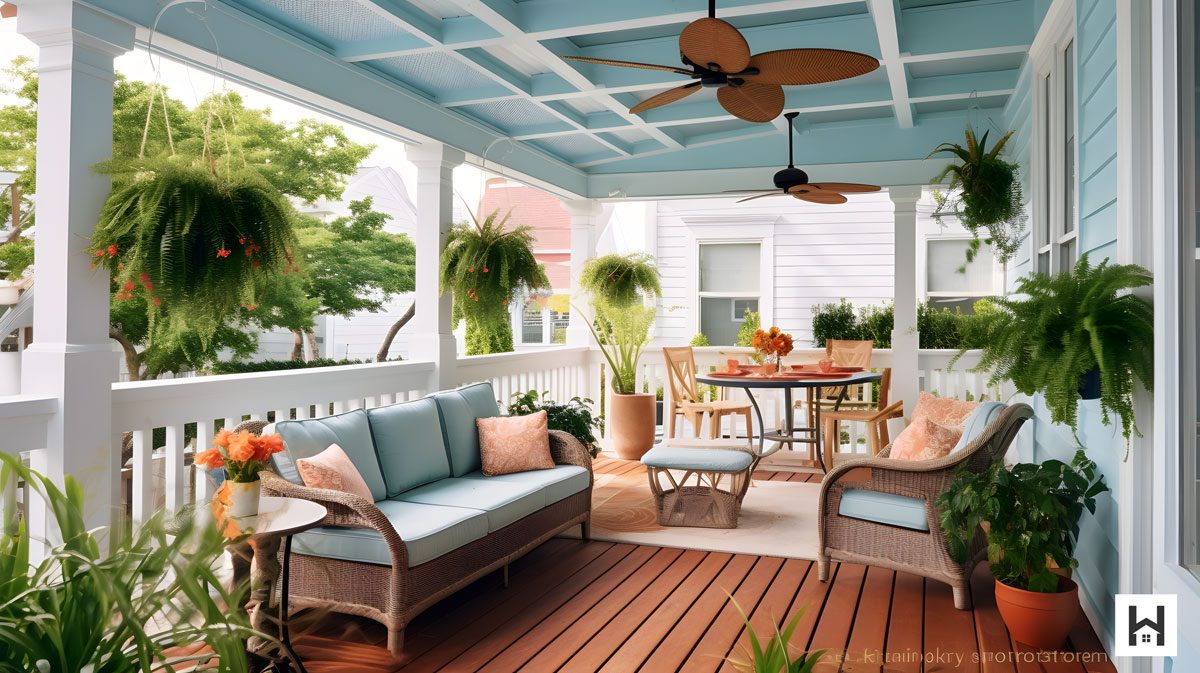
Key Takeaways
- Understanding Porch Ceilings: The porch ceiling plays a crucial role in the overall aesthetic and functionality of your porch. Factors to consider when choosing a porch ceiling include cost, durability, maintenance, and style.
- Exploring Inexpensive Porch Ceiling Materials: There are several budget-friendly materials available for porch ceilings, including vinyl, beadboard, plywood, tongue and groove, drop ceiling, aluminum, fiber cement, reclaimed wood, faux wood panels, corrugated metal, PVC, and composite materials.
- DIY Installation Tips: With some basic tools and patience, many porch ceiling materials can be installed by a handy homeowner. However, professional installation may be necessary for some materials.
- Maintenance: Regular cleaning and maintenance can extend the lifespan of your porch ceiling. The level of maintenance required depends on the material.
- Maximizing Style on a Budget: There are many ways to enhance the style of your porch ceiling without breaking the bank, such as choosing the right color, incorporating lighting, adding texture, and using stylish accessories.
- Cost Comparisons: The cost of a porch ceiling includes not just the cost of the materials, but also the cost of installation and maintenance. It’s important to consider the full cost over the lifetime of the porch ceiling.
- Real-Life Examples: There are many real-life examples of homeowners who have transformed their porch ceilings on a budget, demonstrating that it’s possible to create a beautiful porch ceiling without spending a fortune.
Understanding Porch Ceilings
The Role of a Porch Ceiling
Before we dive into the nitty-gritty, let’s talk about the role of a porch ceiling. It serves several functions. Firstly, it provides protection from the elements, shielding your porch from rain, snow, and harsh sunlight. Secondly, it contributes to the overall aesthetic of your home. A well-designed porch ceiling can add a touch of elegance and charm to your outdoor space. Lastly, it can provide insulation and improve the energy efficiency of your home.
Factors to Consider When Choosing a Porch Ceiling
When choosing a porch ceiling, there are several factors to consider.
- Material: The material you choose needs to be durable and able to withstand outdoor conditions. It should also fit within your budget and match the style of your home.
- Installation: Some materials are easier to install than others. If you’re planning a DIY project, consider the level of difficulty involved in installing the ceiling.
- Maintenance: All porch ceilings require some level of maintenance to keep them looking their best. Consider how much time and effort you’re willing to put into maintaining your porch ceiling.
- Aesthetics: Of course, you want your porch ceiling to look good! Consider the style, color, and texture of different materials to find one that matches your vision.
In the next sections, we’ll explore some inexpensive materials for porch ceilings and provide tips for installation and maintenance. So, stay tuned!
Exploring Inexpensive Porch Ceiling Materials
Vinyl Porch Ceilings: An Affordable Option
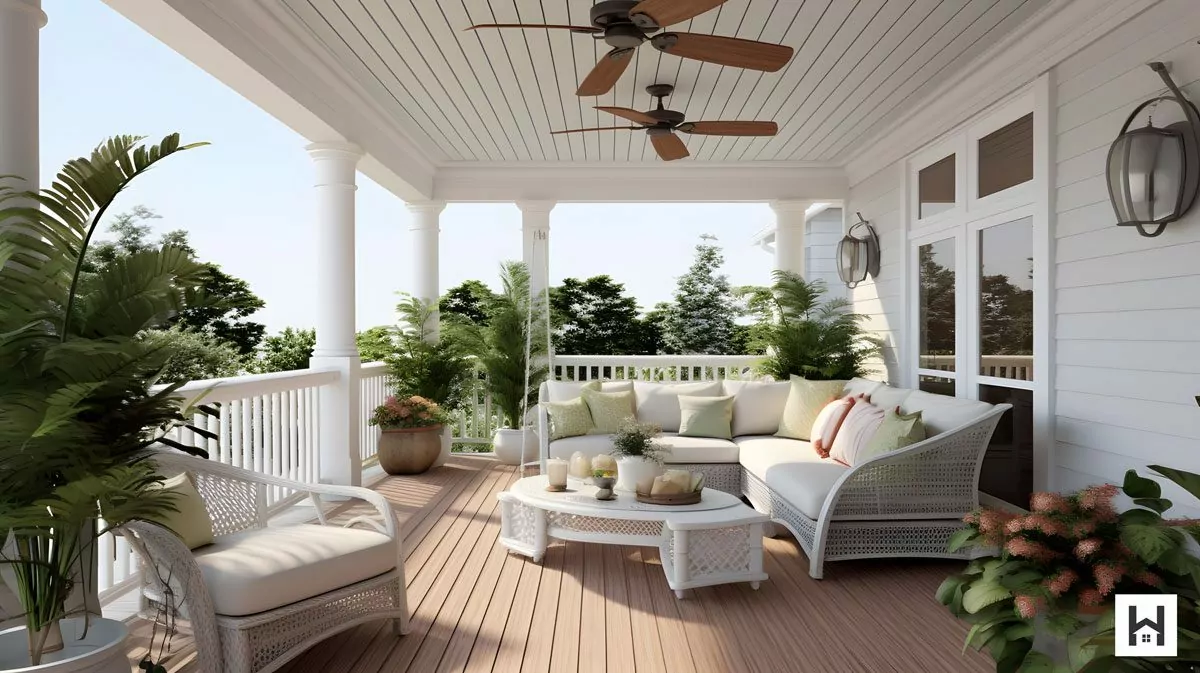
Let’s start with vinyl, a popular choice for porch ceilings. Vinyl is not only affordable but also incredibly durable and easy to maintain. It can withstand harsh weather conditions and doesn’t rot or peel, making it a great long-term investment. Plus, vinyl comes in a variety of colors and styles, so you can easily find something that matches your home’s aesthetic.
The Charm of Beadboard Porch Ceilings
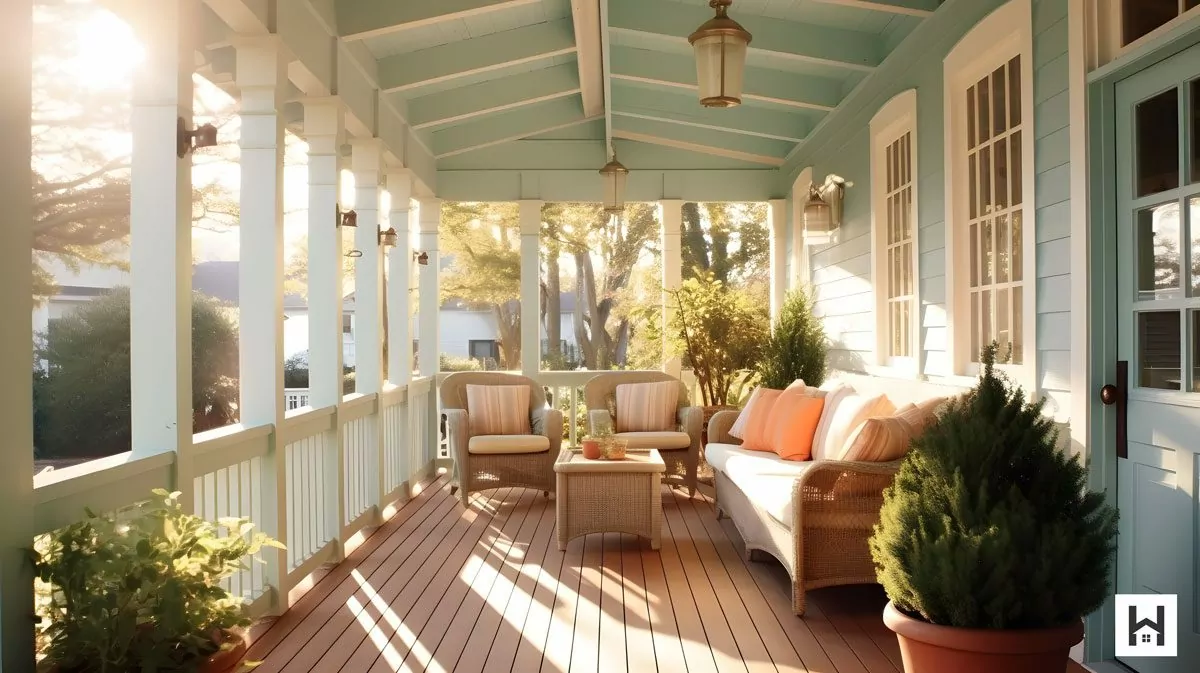
Next up, we have beadboard. Beadboard is a type of paneling that has a charming, vintage look. It’s a fantastic option if you’re going for a traditional or rustic aesthetic. While beadboard can be a bit more expensive than vinyl, it’s still a budget-friendly option, especially if you’re willing to do the installation yourself.
Plywood Porch Ceilings: A Budget-Friendly Choice
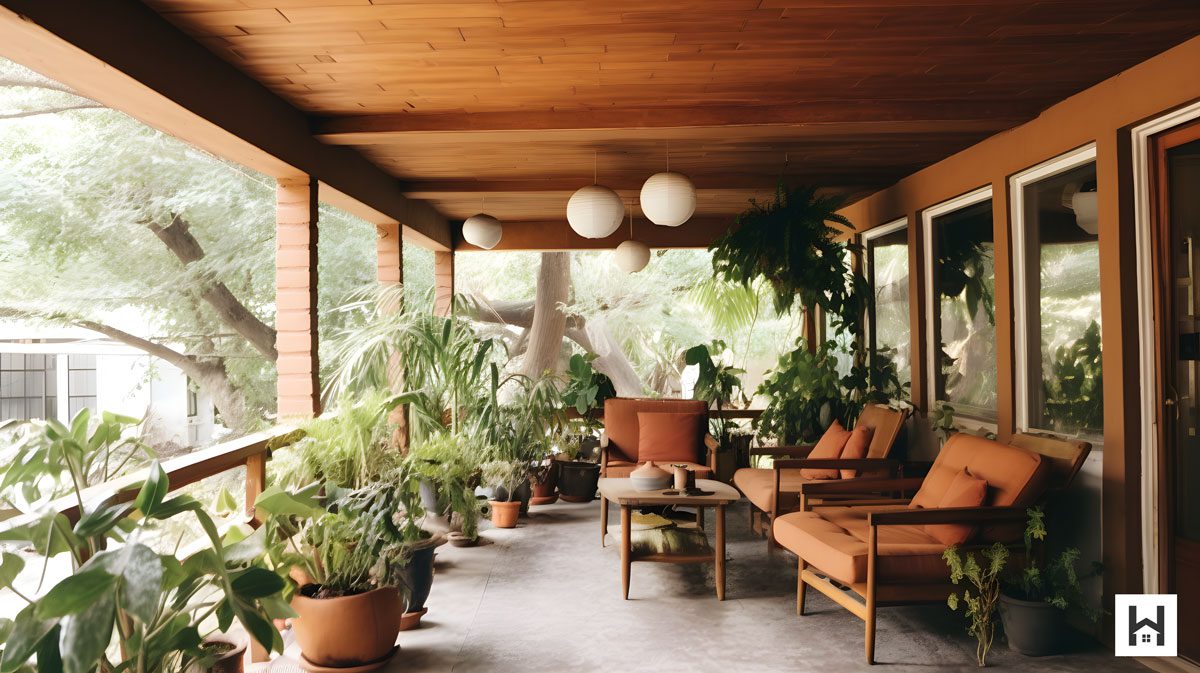
Plywood is another economical option for porch ceilings. It’s easy to install and can be painted or stained to match your desired look. While plywood isn’t as durable as vinyl or beadboard, it can still last a long time with proper maintenance. Plus, it’s one of the most affordable options out there, making it a great choice for budget-conscious homeowners.
Tongue and Groove: A Classic Look
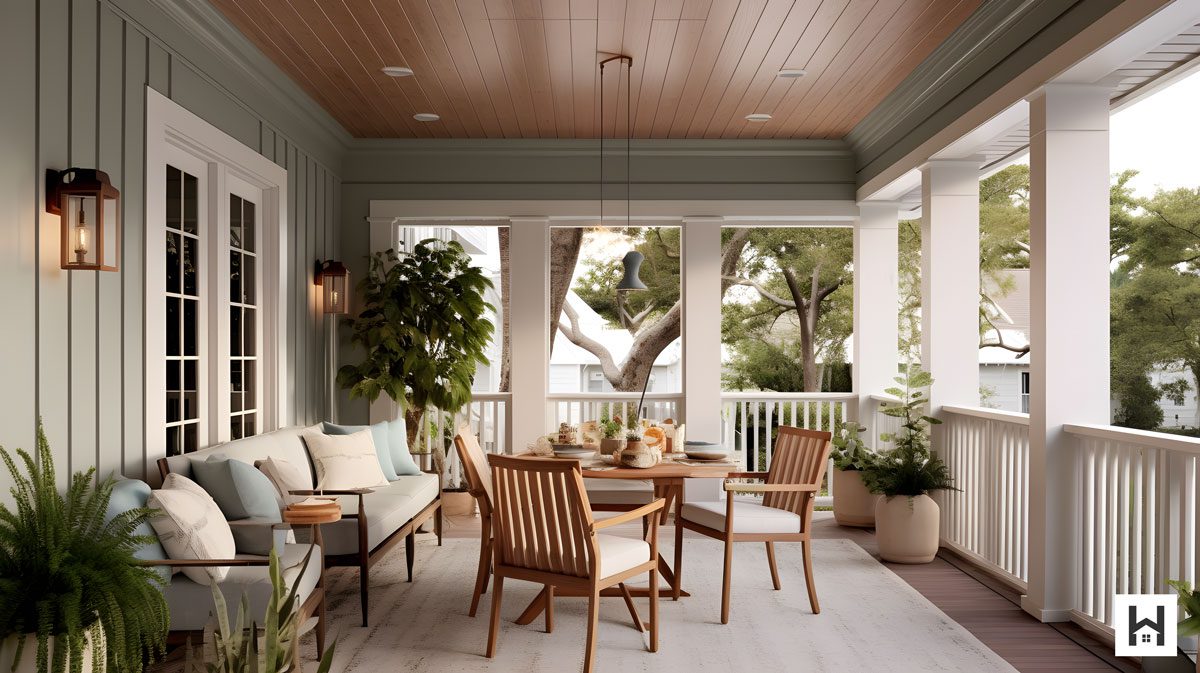
Tongue and groove is a type of siding that has a classic, timeless appeal. It’s a bit more expensive than some of the other options, but it’s still quite affordable. It’s easy to install and can be painted or stained to suit your style.
Drop Ceiling: A Modern Option
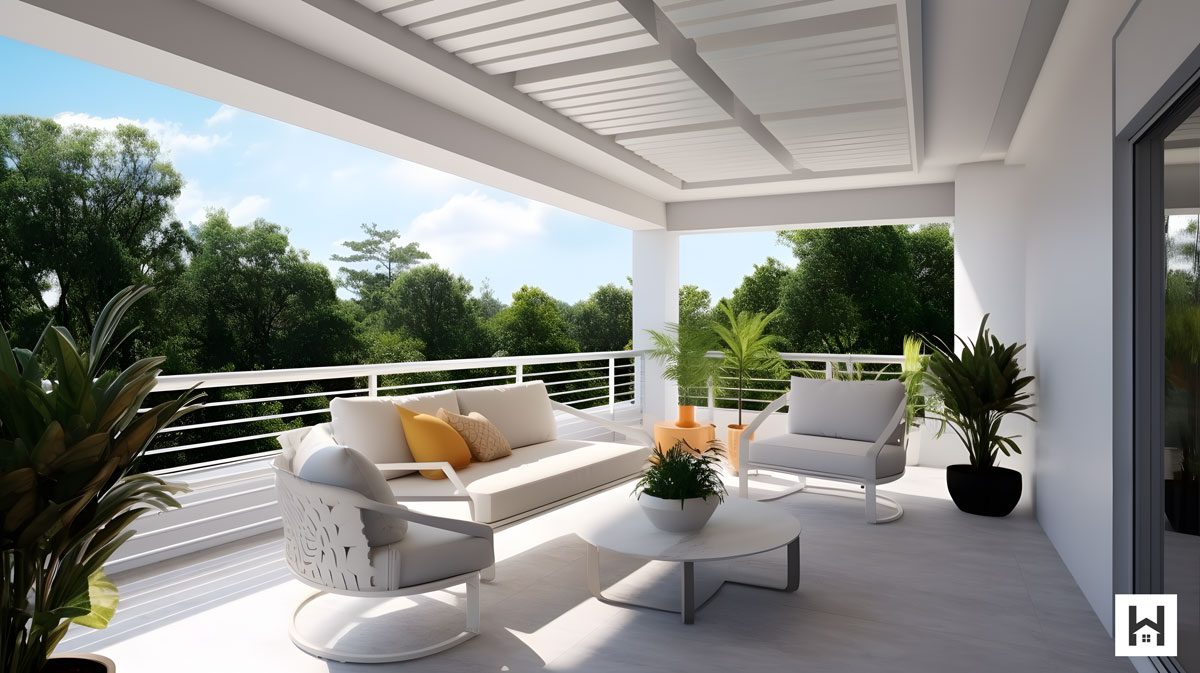
A drop ceiling, also known as a suspended ceiling, is another affordable option. It’s made up of a grid of metal frames, with lightweight tiles or panels dropped into the grid. Drop ceilings are easy to install and can be a great way to hide unsightly elements like pipes or ductwork.
Aluminum: Durable and Low Maintenance
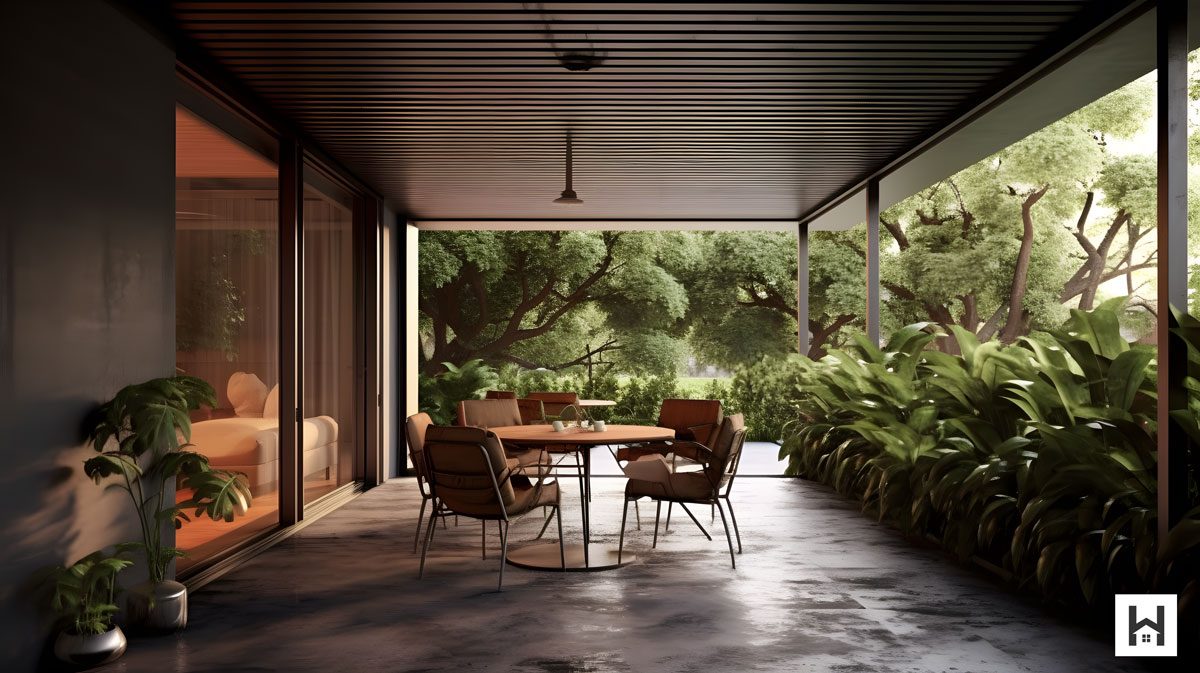
Aluminum is a durable, low-maintenance option for porch ceilings. It’s resistant to rust and corrosion, and it can be painted to match your home’s exterior. Aluminum is a bit more expensive than some of the other options, but it’s a great investment due to its longevity.
Fiber Cement: A Versatile Option

Fiber cement is a versatile material that can mimic the look of wood, stucco, or masonry. It’s durable, resistant to rot and insects, and can be painted any color. While it’s more expensive than vinyl or plywood, it’s still quite affordable compared to other options.
Reclaimed Wood: An Eco-Friendly Choice
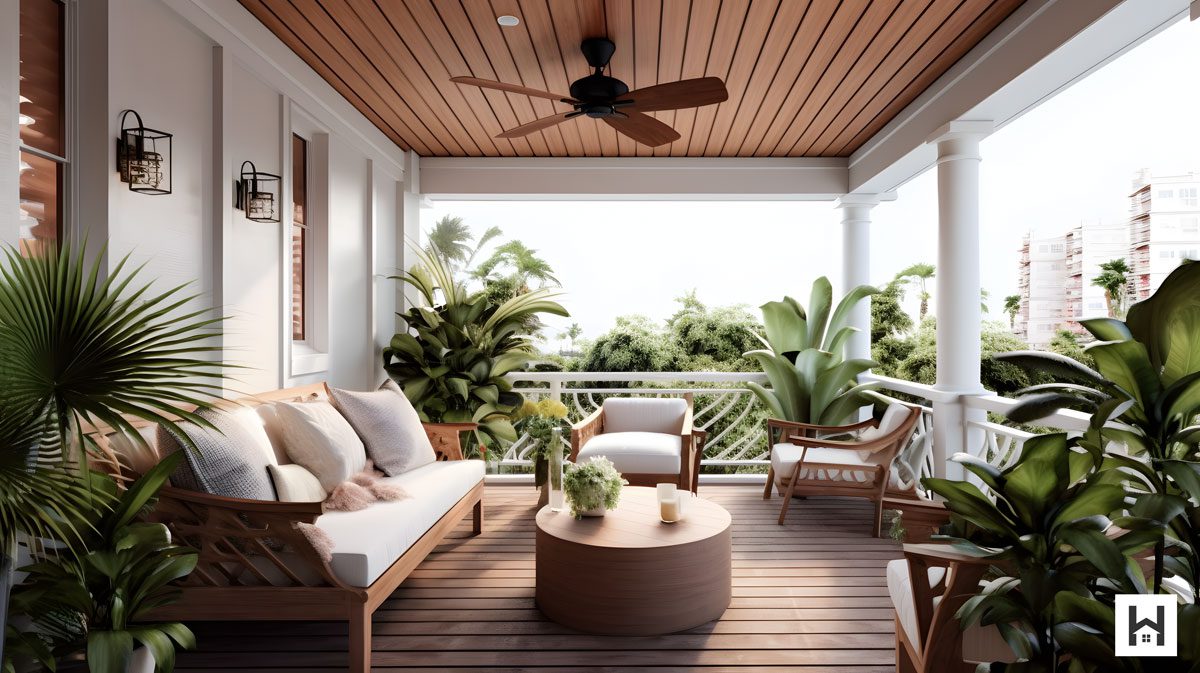
Reclaimed wood is a fantastic option if you’re looking for a sustainable and unique material. Each piece of reclaimed wood has its own history and character, adding a touch of charm and authenticity to your porch. While prices can vary depending on the type and condition of the wood, it can often be found at a lower cost than new wood, making it a budget-friendly choice.
Faux Wood Panels: The Look of Wood Without the Maintenance
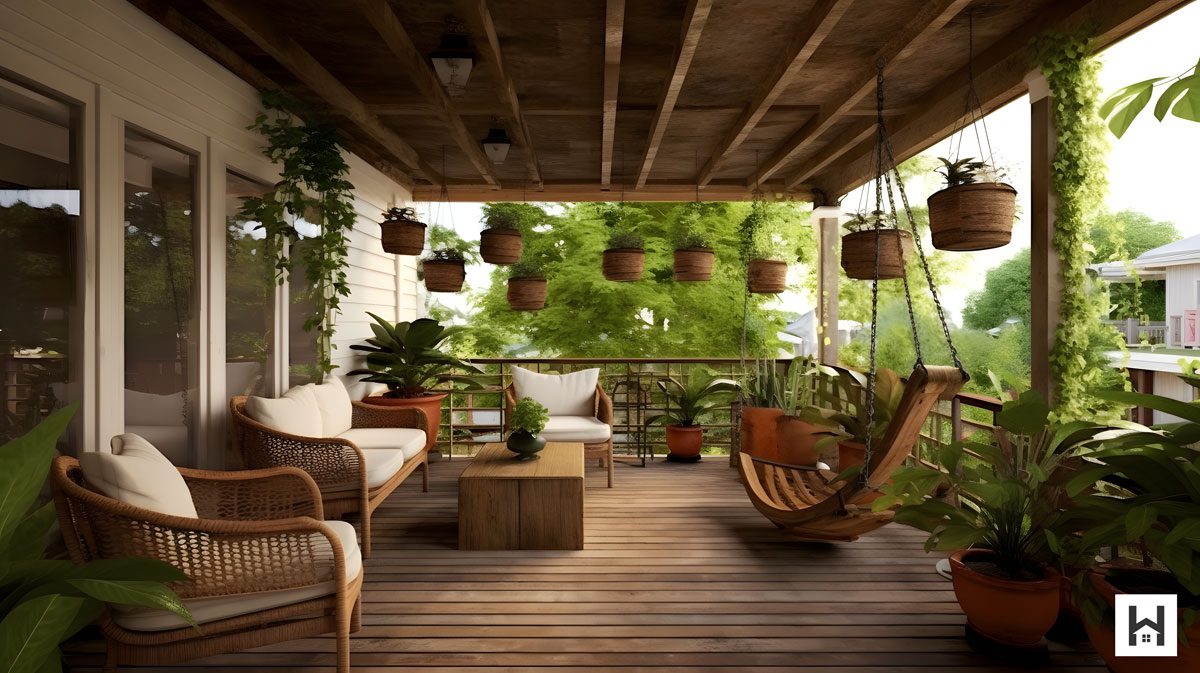
Faux wood panels can give you the look of a wooden porch ceiling without the maintenance. These panels are typically made from a type of plastic or vinyl and are designed to mimic the look of various types of wood. They’re resistant to rot and insects, and they won’t warp or fade over time.
Corrugated Metal: A Rustic, Industrial Look
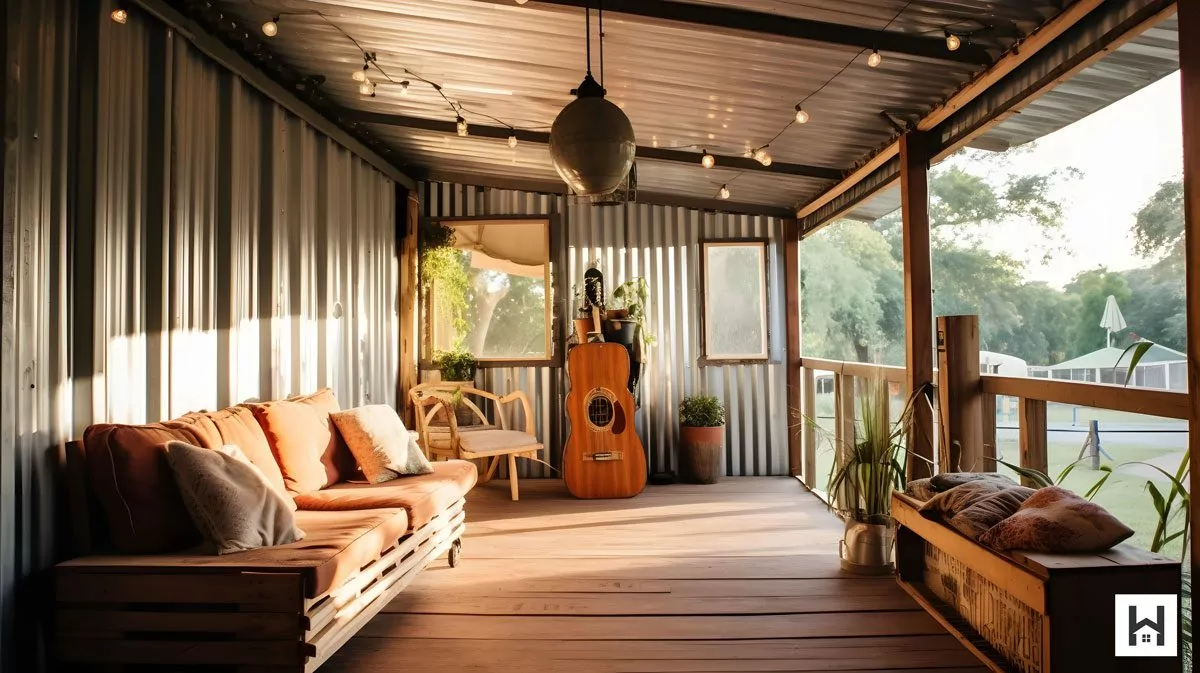
Corrugated metal can give your porch a unique, rustic look. It’s durable, weather-resistant, and relatively inexpensive. Plus, it’s lightweight and easy to install, making it a great choice for a DIY project.
PVC: A Versatile and Durable Option

PVC, or polyvinyl chloride, is a type of plastic that’s durable, waterproof, and affordable. It’s resistant to rot and insects, and it can be painted to match your home’s exterior. PVC is also lightweight and easy to install, making it a great choice for a DIY project.
Composite: A Long-Lasting, Low-Maintenance Option
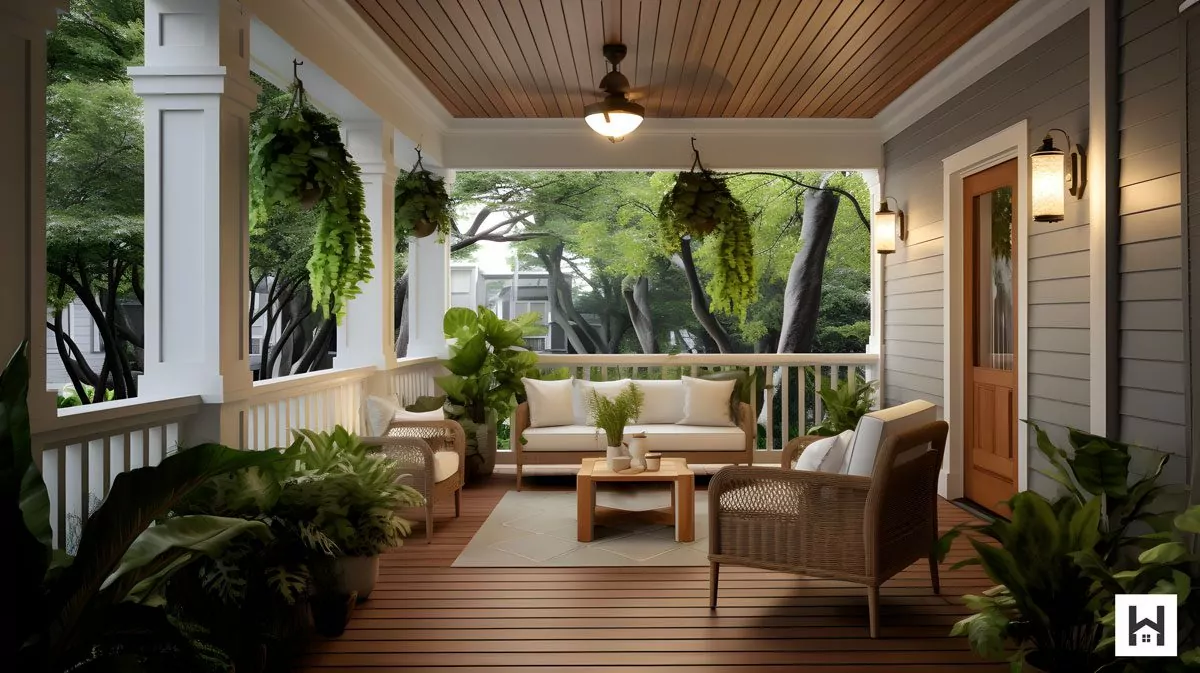
Composite materials are made from a mixture of wood fibers and plastic. They’re designed to mimic the look of wood, but they’re more durable and require less maintenance. Composite materials are resistant to rot, insects, and fading, making them a great long-term investment. While they’re more expensive upfront than some other options, they can save you money in the long run due to their durability and low maintenance requirements.
Remember, the best material for your porch ceiling depends on your budget, your home’s style, and your personal preferences. In the next section, we’ll provide some tips for installing these materials, so stay tuned!
DIY Installation Tips for Inexpensive Porch Ceilings
Preparing for Installation
Before you start installing your porch ceiling, it’s important to prepare. First, measure your porch to determine how much material you’ll need. Don’t forget to account for any fixtures or fittings. Next, gather all the necessary tools. This might include a ladder, a saw, a drill, and safety equipment like gloves and goggles. Finally, check the weather forecast. You don’t want to start your project only to be interrupted by rain or snow!
Step-by-Step Guide to Installing Vinyl Porch Ceilings
Installing a vinyl porch ceiling can be a straightforward process. Here’s a basic step-by-step guide:
- Start by attaching furring strips to the existing ceiling. These will provide a surface to attach the vinyl to.
- Next, cut your vinyl panels to the correct length. Always measure twice to avoid mistakes!
- Attach the vinyl panels to the furring strips using nails or screws. Start from one end of the porch and work your way to the other.
- Make sure to overlap the vinyl panels slightly to prevent water from seeping through.
- Finally, trim any excess material and add any finishing touches.
Tips for Installing Beadboard Porch Ceilings
Beadboard can be a bit trickier to install than vinyl, but it’s still doable with some patience and care. Here are some tips:
- Beadboard panels usually come in large sheets, which can be difficult to handle. Consider cutting them into smaller sections for easier installation.
- Use a level to ensure your beadboard is installed straight. This is especially important if your porch has an uneven ceiling.
- Beadboard can be painted or stained before or after installation. However, painting or staining before installation can make the process easier and less messy.
How to Install a Plywood Porch Ceiling
Plywood is a great option for DIY enthusiasts because it’s easy to work with. Here’s a basic guide to installing a plywood porch ceiling:
- Start by measuring and cutting your plywood sheets to the correct size.
- Attach the plywood to the existing ceiling using screws. Make sure to screw into the ceiling joists for a secure fit.
- Fill any gaps or seams with wood filler, then sand smooth.
- Finally, paint or stain your plywood ceiling to your desired color.
Common Mistakes to Avoid During Installation
When installing your porch ceiling, there are a few common mistakes to avoid. These include not measuring correctly, not using the right tools, not preparing the surface properly, and not following safety precautions. By avoiding these mistakes, you can ensure a smooth and successful installation.
In the next section, we’ll discuss how to maintain your new porch ceiling, so it continues to look great for years to come. So, stay tuned!
Maintaining Your Inexpensive Porch Ceiling
Cleaning and Maintenance Tips for Vinyl Porch Ceilings
Vinyl is a low-maintenance material, but it still needs some care to keep it looking its best. Regularly clean your vinyl porch ceiling with a mild detergent and water to remove dirt and grime. Use a soft brush or cloth to avoid scratching the surface. If you notice any mold or mildew, a solution of bleach and water can help remove it. Remember to rinse thoroughly after cleaning.
How to Maintain a Beadboard Porch Ceiling
Beadboard requires a bit more maintenance than vinyl. Regularly dust your beadboard ceiling to prevent dirt buildup. If your beadboard is painted, you may need to repaint it every few years to keep it looking fresh. If it’s stained, consider applying a fresh coat of sealant every few years to protect the wood and maintain its appearance.
Caring for Your Plywood Porch Ceiling
Plywood is a durable material, but it can be prone to water damage if not properly maintained. Regularly check your plywood ceiling for signs of water damage, such as discoloration or warping. If your plywood is painted, you may need to repaint it every few years to protect it from the elements. If it’s stained, consider applying a fresh coat of sealant every few years.
When to Consider a Porch Ceiling Replacement
No matter what material you choose, your porch ceiling won’t last forever. If you notice signs of serious damage, such as rotting wood or large cracks, it may be time to consider a replacement. Regular maintenance can help extend the life of your porch ceiling, but eventually, you’ll need to replace it.
In the next section, we’ll explore how to maximize style on a budget, so stay tuned!
Maximizing Style on a Budget
Choosing the Right Color for Your Porch Ceiling
Color can have a big impact on the look and feel of your porch. Traditional porch ceilings are often painted a light blue, a practice that originated in the Southern United States. This color is said to repel insects and extend daylight. However, you can choose any color that suits your style and complements your home. Remember, lighter colors can make your porch feel larger and more open, while darker colors can create a cozy, intimate feel.
Incorporating Lighting into Your Porch Ceiling
Lighting is another important element of porch design. Consider installing recessed lighting in your porch ceiling for a clean, modern look. You could also hang a statement light fixture for a more traditional or rustic look. If you’re on a tight budget, string lights or lanterns can add a charming touch without breaking the bank.
Adding Texture to Your Porch Ceiling
Adding texture to your porch ceiling can create visual interest and enhance the overall design. For example, beadboard adds a classic, cottage-like texture. You could also consider materials like tin tiles for a vintage look, or wood planks for a rustic feel.
Stylish Accessories for Your Porch Ceiling
Finally, don’t forget about accessories. Hanging plants, wind chimes, or even an outdoor ceiling fan can add style and functionality to your porch. These accessories can also help to make your porch feel more like an outdoor living space.
Remember, creating a stylish porch doesn’t have to be expensive. With a bit of creativity and planning, you can create a beautiful porch ceiling on a budget. In the next section, we’ll compare the costs of different porch ceiling materials, so stay tuned!
Cost Comparisons Between Different Porch Ceiling Materials
| Material | Approximate Cost per Sq Ft | Durability | Maintenance Level |
|---|---|---|---|
| Vinyl | $2 – $7 | High | Low |
| Beadboard | $3 – $7 | Medium | Medium |
| Plywood | $1 – $3 | Low | High |
| Tongue and Groove | $2 – $5 | Medium | Medium |
| Drop Ceiling | $2 – $6 | Medium | Low |
| Aluminum | $3 – $6 | High | Low |
| Fiber Cement | $2 – $5 | High | Low |
| Reclaimed Wood | Varies | Medium | High |
| Faux Wood Panels | $2 – $7 | High | Low |
| Corrugated Metal | $1.50 – $5 | High | Low |
| PVC | $2 – $5 | High | Low |
| Composite | $4 – $9 | High | Low |
Cost of Vinyl Porch Ceilings
Vinyl is one of the most affordable options for porch ceilings. The cost can vary depending on the style and quality of the vinyl, but you can generally expect to pay between $2 and $7 per square foot. This price typically includes the cost of the vinyl itself, but not the cost of installation, which can add an additional $1 to $3 per square foot.
Pricing for Beadboard Porch Ceilings
Beadboard is a bit more expensive than vinyl, but still relatively affordable. You can expect to pay between $3 and $7 per square foot for beadboard, not including installation. Installation can add an additional $2 to $5 per square foot. However, you can save on installation costs by doing it yourself.
The Affordability of Plywood Porch Ceilings
Plywood is another budget-friendly option for porch ceilings. The cost of plywood can vary widely depending on the type and quality, but you can generally expect to pay between $1 and $3 per square foot. Installation can add an additional $1 to $3 per square foot.
Understanding the Full Cost: Materials, Installation, and Maintenance
When comparing the costs of different porch ceiling materials, it’s important to consider not just the cost of the materials themselves, but also the cost of installation and maintenance. Some materials may be cheaper upfront, but require more expensive installation or maintenance. Therefore, it’s important to consider the full cost over the lifetime of the porch ceiling.
In the next section, we’ll look at some real-life examples of inexpensive porch ceiling transformations, so stay tuned!
Real-Life Examples of Inexpensive Porch Ceiling Transformations
Case Study: Transforming a Porch with Vinyl
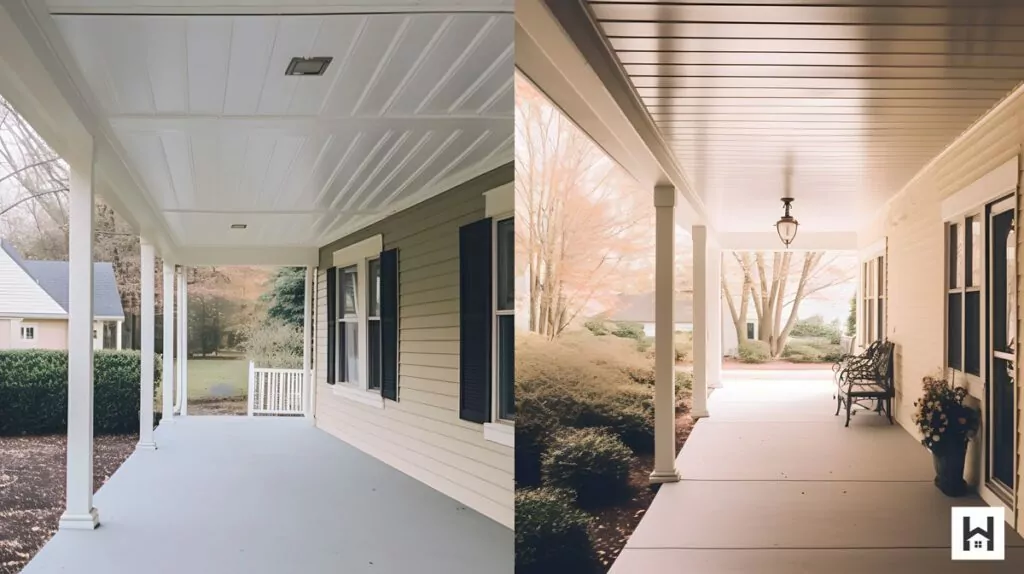
Let’s start with a homeowner named Alex. Alex wanted to give his porch a fresh, modern look without spending a fortune. He decided to use vinyl for his porch ceiling. He chose a white, beaded vinyl that mimicked the look of more expensive beadboard. With some help from a friend, Alex was able to install the vinyl ceiling in a weekend. The result was a bright, clean-looking porch that Alex was proud to show off. The total cost for the project was around $500, including materials and a few new tools.
Case Study: A Beadboard Porch Ceiling Makeover
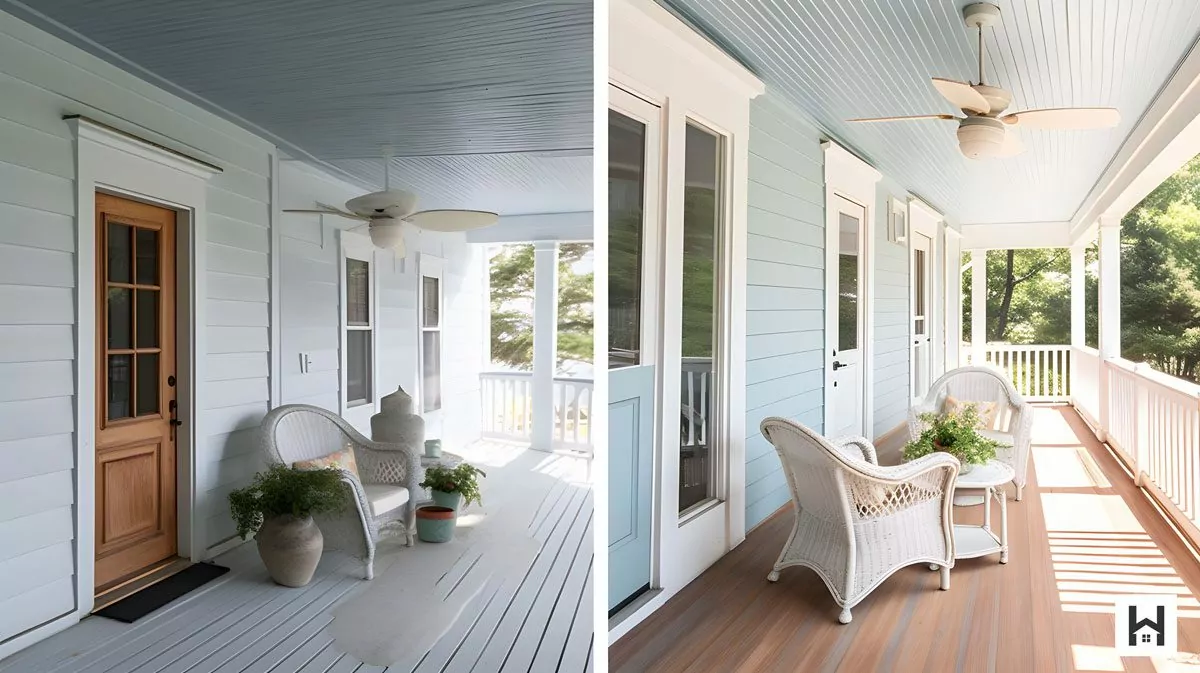
Next, let’s look at a homeowner named Lisa. Lisa’s porch had an old, worn-out plywood ceiling. She wanted to replace it with something more stylish. After doing some research, she decided on beadboard. Lisa was able to find beadboard panels at her local home improvement store for a reasonable price. She painted the beadboard a light blue color before installing it. The installation process was a bit challenging, but Lisa was able to do it herself with some patience and perseverance. The end result was a charming, cottage-style porch that added curb appeal to Lisa’s home. The total cost for the project was around $700.
Case Study: A Plywood Porch Ceiling on a Budget
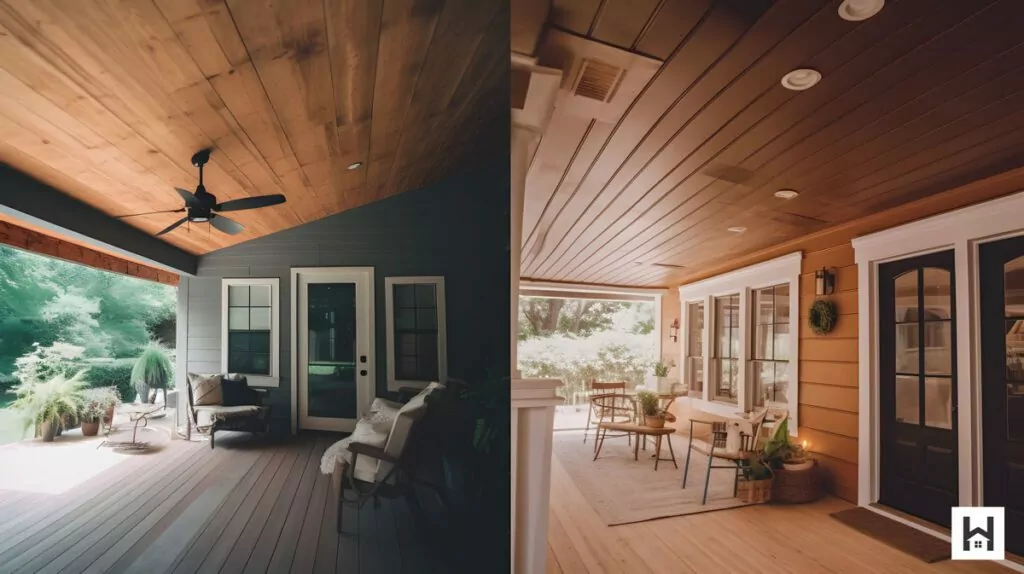
Finally, let’s look at a homeowner named Mark. Mark’s porch had a damaged vinyl ceiling that needed to be replaced. Mark was on a tight budget, so he decided to use plywood for his new ceiling. He was able to find affordable plywood sheets at his local lumber yard. Mark stained the plywood a dark brown color to match his home’s exterior. With some help from his neighbor, Mark was able to install the plywood ceiling in a day. The result was a rustic, cozy porch that Mark and his family enjoyed spending time on. The total cost for the project was around $300.
These case studies show that it’s possible to transform your porch ceiling on a budget. With some creativity and hard work, you can create a porch ceiling that you love without breaking the bank. In the next section, we’ll answer some frequently asked questions about inexpensive porch ceilings, so stay tuned!
Enhancing Porch Ceilings Creatively and Affordably
Creative Fabric and Curtain Additions
To add a cozy vibe and depth to your porch area, consider using fabrics or curtains. They not only provide shade but also enhance the ambiance. Lightweight curtains or bamboo reed screens can be hung around the porch to create a secluded, intimate space. This is a low-cost way to add a decorative touch while also serving a functional purpose.
Utilizing Stencils and Wallpaper for Ceiling Decor
Transform your porch ceiling inexpensively by using stencils or wallpaper. Stencils allow for creative patterns and designs, adding a unique element to your outdoor ceiling. Wallpaper, especially designed for exterior use, can add texture and color, enhancing the overall decor without a significant cost.
Repurpose and Recycle for Unique Decor
Incorporate repurposed or recycled items for a unique ceiling design. Old boards can be refurbished into a plank ceiling, or recycle vinyl beadboard for a refreshed look. This approach not only cuts costs but also adds a unique charm to your porch area.
Integrating Bamboo and Reed for a Natural Touch
Bamboo and reed elements can be creatively used in the porch ceiling designs. They bring a natural, earthy feel to the space and are both affordable and durable. Incorporate them as a part of the ceiling or as an accessory to add to the exterior ceiling ideas.
Creative Ceiling Paint and Patterns
Experiment with ceiling paint colors and patterns to give your porch a distinct look. A contrasting paint color can make the ceiling stand out, enhancing the overall design elements of the porch. Patterns painted on the ceiling can add visual interest and depth.
Incorporating Pendant Lights and Ceiling Features
Pendant lights or other ceiling fixtures add warmth and atmosphere to your porch. They can be an affordable addition that enhances the porch lighting and contributes to the overall ceiling design. Beamed ceilings or exposed beams can also add character to the space.
Low-Cost Creative Porch Ceiling Ideas
| Idea | Description | Benefit |
|---|---|---|
| Fabric Curtains | Use lightweight fabrics for shade and privacy | Adds ambiance, easy to change |
| Stenciled Patterns | Paint patterns directly onto the ceiling | Customizable, creative touch |
| Recycled Materials | Use repurposed boards or vinyl beadboard | Eco-friendly, cost-effective |
| Bamboo/Reed | Integrate natural elements into the design | Adds a natural vibe, durable |
| Ceiling Paint | Experiment with colors and patterns | Visually appealing, inexpensive |
| Pendant Lights | Add lighting fixtures for warmth | Enhances atmosphere, functional |
By using these creative and low-cost ideas, you can significantly enhance the decor of your porch or patio, making it a more inviting and enjoyable outdoor living space.
Frequently Asked Questions about Inexpensive Porch Ceilings
Can I Install a Porch Ceiling Myself?
Yes, you can! Many porch ceiling materials, such as vinyl, beadboard, and plywood, can be installed by a handy homeowner. However, keep in mind that you’ll need some basic tools and a bit of patience. If you’re not comfortable with DIY projects, you might want to hire a professional.
How Long Does a Porch Ceiling Last?
The lifespan of a porch ceiling depends on the material and how well it’s maintained. Vinyl and beadboard can last for decades with proper care. Plywood is less durable, but can still last for many years if it’s properly sealed and maintained.
What is the Most Durable Material for a Porch Ceiling?
Vinyl is one of the most durable materials for a porch ceiling. It’s resistant to rot, insects, and weather damage. However, beadboard and plywood can also be quite durable if they’re properly installed and maintained.
How Can I Make My Porch Ceiling More Stylish?
There are many ways to make your porch ceiling more stylish. You can paint or stain it a unique color, add texture with materials like beadboard, or incorporate stylish accessories like lighting or hanging plants. The key is to choose a style that complements your home and reflects your personal taste.
Conclusion
We’ve covered a lot of ground in this article, from understanding the role of a porch ceiling to exploring different materials, installation tips, and maintenance advice. We’ve also looked at real-life examples of porch ceiling transformations and answered some frequently asked questions.
Now, it’s your turn! With a bit of planning and creativity, you can transform your porch ceiling into a stylish and functional feature of your home. Whether you choose vinyl, beadboard, or plywood, remember that the best porch ceiling is one that fits your budget, complements your home, and makes you happy. So, why wait? Start planning your porch ceiling project today. You’ve got this!


